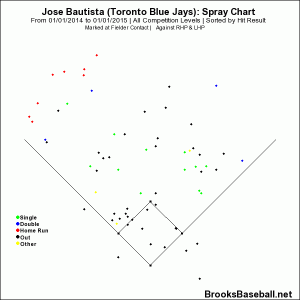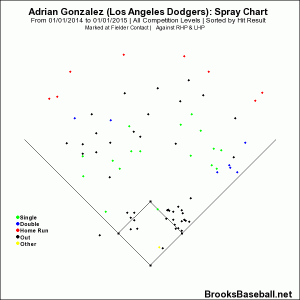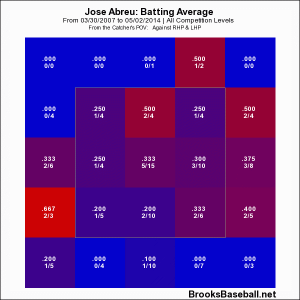It’s hard to imagine a player having a better first month in the big leagues than Jose Abreu did in April. He managed to lead all Major Leaguers in home runs (10) and RBI (31) while totaling more bases than any other player as well. His presence in the lineup has been the lightning bolt that electrified the White Sox offense Frankenstein offense back to life and thanks to a brilliantly balanced approach at the plate the Cuban slugger shows no signs of slowing down anytime soon.
But what’s most impressive about Abreu isn’t the sheer number of homers he’s hitting, it’s the way he’s gone about it. He has managed to park souvenirs in nearly every corner of the outfield stands, which not only demonstrates excellent power but perfect balance at the plate as well. Just take a look at his spray chart this year:
That balance, particularly on hits to the outfield is bananas. Abreu has actually walloped more homers to right field than to left, while actually showing a marked preference for the deepest part of the ballpark, parking 4 long balls to straight away center field. That balance may be somewhat susceptible to the dreaded small sample size monster, but it’s also unseen in nearly every other one of the game’s top sluggers. Take a look at what Jose Bautista, who’s 3rd in the AL in home runs has done:
Or Albert Pujols, who ranks 2nd in the AL with 9 deep shots thus far:
Really, the only player in baseball who’s even doing anything remotely on the same plane as Abreu is Adrian Gonzalez, a 4-time All-Star who’s off to a scorching start:
But even Gonzalez doesn’t approach his at-bats in the same way Abreu does. Most of Gonzalez’s damage at the plate comes on pitches that run from the middle of the plate to the inside corner. Gonzalez, like most sluggers, looks for pitches that run from the middle of the plate to the inside corner, in the hopes that he can pull the ball out of the yard. And, as evidence shows, the Dodgers’ 1st baseman is currently hitting .458 on pitches middle-in, while struggling for the most part on pitches away.
Abreu, on the other hand, has managed to seek out those outside pitches, driving the to right field with great authority.
According to the chart from Brooks Baseball, Abreu is actually hitting pitches that are off the outside corner of the plate better than he’s hit pitches in on his hands in the strike zone. Again, that’s an extremely unique trait in a power hitter and it makes life extremely difficult for any pitcher on the mound. Abreu has essentially taken away the easiest parts of the plate to pitch to, leaving only the inside corner, which is often dangerous territory to enter for a pitcher. Often times if a pitcher misses his location inside he either gives up a base by hitting the batter or he gives up something much, much worse by leaving a meatball over the heart of the plate.
Another problem opposing pitchers appear to be having is the inability to get a fastball past the White Sox slugger. The initial scouting report on Abreu included references to his next-level power, but there was a lot of concern that he wouldn’t be able to handle the Major Leagues’ best fastballs. Those report have almost immediately been proven hilariously incorrect. Abreu has already homered off of Cy Young winners Justin Verlander and David Price as well as young talent Chris Archer, who routinely hits 95 with his heater. And if those moonshots aren’t enough evidence for you, Abreu’s .372 batting average against fastballs should be more than enough to suffice.
What will really be fascinating to watch over the next month is exactly how pitchers react to these early returns. Abreu has shown the ability to successfully hit pitches of all types in almost every location in the zone. My guess would be that opposing pitchers will eventually throttle down on the fastballs in favor of more breaking pitches, but even that might not do it. Abreu has whiffed on 40% of his swings at breaking balls this year, but even then he’s still hitting .242 against pitches that Brooks Baseball classifies as such. He’s actually been one of the 4 or 5 best hitters in baseball against sliders so that pitch is probably out as well. Really, the only thing Abreu hasn’t hit is the change-up and lucky for him only a handful of big league pitchers actually have Grade-A quality equalizers.
It’s also fairly safe to guess that pitchers will begin to test Abreu’s patience by working even further outside of the strike zone. Abreu’s taken a fairly aggressive approach at the plate, drawing walks in just 7% of his plate appearances thus far. Abreu has also swung at 38.1% of pitches out of the strike zone, which currently ranks him in the top 20 in baseball for free swingers. This is easily the most exploitable area of Abreu’s game, but I severely doubt the league’s ability to further exploit that weakness because there isn’t too many more pitches available for the slugger to actually swing at. That and the fact that Abreu’s actually been pretty damn good even when pitchers expand the zone. All-Star caliber players like Brandon Phillips and the now-retired Vladimir Guerrero have been making hay with this free-swinging approach for years, mostly due to their abilities to turn bad pitches into solid contact. Jose Abreu appears to have that same otherworldly ability as well and the White Sox should be reaping the benefits from that skill for years to come.
Big thanks to Fangraphs, Brooks Baseball, and Baseball Reference for the statistical support!






The one part of Abreu’s spray chart that is not so encouraging are his infield outs. There are a lot of them and nearly all are to the left side. Combine that with the knowledge that Abreu hits the outside pitch well, it may be that pitchers can jamb him with the inside pitch, resulting in weak grounders (or pop-ups) to short or third.
So far, that hasn’t hurt him too much with only 2 GIDP, and advancing 100% of runners on 2nd with 0 or 1 out. But, somehow he has had only 2 PA (!) this year with that situation. Once that normalizes, all those groundouts to the left side won’t be so benign.
I don’t know about next level hitting but that’s some next level content right there! The best comp to me seems to be Guerrero. That said Vlad’s arm made him a respectable right fielder (RFIELD agrees with me for once, +7 career) and this guy is a below average first basemen. He’s also already 27. Years to come may be a stretch. Vlad stopped being productive when his bat speed faded and he couldn’t cover the double sized strike zone any longer to match his swing-first style.
Vlad didn’t have a positive WAA past age 33 and this contract runs through Abreu’s age 32. Put that on top of the positional adjustment of 1B vs RF and the defensive adjustment (above average vs below at their respective positions over the age range in question) and I doubt the white sox have a budding star on their hands. What they do have is a guy who will put up big triple crown stats and be one of the most over-rated players in baseball. They’ll get their money’s worth and maybe some extra value in fans wanting to see a hitter knock a ball in the other batter’s box out of the ballpark but not much more. Another small difference, Vlad had a positive Rbase over ages 27-32 stealing over 90 bases. I don’t think that’s in the projections for Abreu.
I don’t share your projection but I think your content is exceptional in detail, presentation, and style. Color me impressed!
I wish we had spray charts like this for Guerrero. He hit like nobody I’ve ever seen. Did he really hit a double on the hop? Knock one out that was above his neck? https://www.youtube.com/watch?v=7Bqj3jynJnU Yep, I didn’t dream it though I guess the double part has more to do with the error than anything else.
Another thing vlad didn’t do was strike out a lot, at least by modern standards. 27-32 Vlad struck out in 10% of PA’s. He had more walks that strikeouts during those 6 years as unlikely as that sounds. Abreu’s at 22% of PA’s so far with basically a 4:1 SO:BB ratio.
Its a little absurd to outright declare Abreu a negative defender after 20-30 games. Let’s give him a chance here and keep in mind that defensive statistics are terribly unreliable this early in the year and terribly inaccurate for 1st baseman in general.
“It’s hard to imagine a player having a better first month in the big leagues than Jose Abreu did in April.”
Yasiel Puig made his debut on June 3 last year; at the end of June he was hitting .436/.467/.713 with 7 HR, for a 227 OPS+, and had made a few notable defensive plays to boot. If we’re talking about one hot month, I’d say that stacks up pretty well with Abreu’s line of .270/.336/.617 (165 OPS+) this April. Of course Abreu has a better chance of maintaining something like that level of productivity than Puig did….
Anyway, thanks for the interesting analysis.